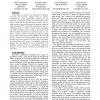Free Online Productivity Tools
i2Speak
i2Symbol
i2OCR
iTex2Img
iWeb2Print
iWeb2Shot
i2Type
iPdf2Split
iPdf2Merge
i2Bopomofo
i2Arabic
i2Style
i2Image
i2PDF
iLatex2Rtf
Sci2ools
WECWIS
2005
IEEE
2005
IEEE
Electronic Trading in Order-Driven Markets: Efficient Execution
In this paper, we address the importance of efficient execution in electronic markets. Due to intense competition for profit opportunities, trading costs can represent a significant portion of overall return. They must be taken into account both when a specific trade is being executed, and when a general investment strategy is being designed. We empirically demonstrate that by combining market orders (which offer immediate execution regardless of price) and limit orders (which offer uncertain execution at a specified price), we are able to obtain a superior average price than by using market orders only. Our analysis highlights the trade-off between expected price improvement from limit orders and the risk of non-execution. We show how to determine the optimal limit order price in a simplified setting and suggest how this approach can be generalized to a complete solution. All of our experimental results are obtained on an extensive collection of NASDAQ limit order data.
| Added | 25 Jun 2010 |
| Updated | 25 Jun 2010 |
| Type | Conference |
| Year | 2005 |
| Where | WECWIS |
| Authors | Yuriy Nevmyvaka, Michael S. Kearns, Amy Papandreou, Katia P. Sycara |
Comments (0)

